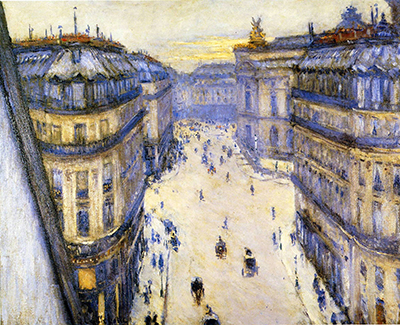Rue Halevy, Seen from the Sixth Floor is one of many oil on canvas paintings by French artist Gustave Caillebotte. Rue Halevy was completed in 1878 and is currently owned by a private collector.
The painting itself measures 60cm wide by 73cm high and, as the name suggests, portrays Rue Halevy, a boulevard in Paris, as seen from the balcony of the 6th floor of one of the adjacent buildings. Paintings of urban Paris are common amongst the artistic works of Caillebotte, which include Paris Street; Rainy Day (1875), and Boulevard, Seen from Above (1880). In his paintings, Caillebotte has effectively captured a significant period in the overall history of Paris. During the 19th century, Paris was in the midst of a phenomenal urban restructuring, which saw the demolition of the old medieval Paris and the creation of the contemporary French capital city.
Rue Halevy was one such street; the old and confined area had been replaced with wide boulevards, lined with uniform buildings of the prime of Parisian architecture, and was completed with an opera house, visible in the distance. Caillebotte has captured the grandeur of this contemporary Parisian area, which was made possible via innovative mass-renovation. During the late 19th century, impressionism was cultivated by the artists of Paris, and Caillebotte was no exception. Rue Halevy was painted to depict the accurate representation of light as it falls on the area, with short and minimal brush strokes, combined with the accurate depiction of colour schemes and shadows.
This is evident in Rue Halevy as some areas of the adjacent buildings are darker due to the surrounding shadows. To capture the essence or fundamental characteristics or the area is a cardinal feature of impressionism, rather than seeking to express every minute detail, which provides an aesthetically soothing image. This gives the viewer a greater sense of appreciation for the 'big picture' and has rendered the painting as more vivid. As a testament to his skill, Caillebotte has seized the movement of the people below, as though they were frozen in time crossing the road and walking the pavement.
When combined with Paris Street; Rainy Day (1875), the general attire of pedestrians is present in the minds of the viewers, and Caillebotte offers his contemporary viewers a glimpse into a moment of 19th century life on Rue Halevy, as though they were observing the panorama from the 6th floor. The paintings of Caillebotte are all testaments to his skill and devotion to the arts. Rue Halevy, Seen from the Sixth Floor exquisitely reinforces this notion.




